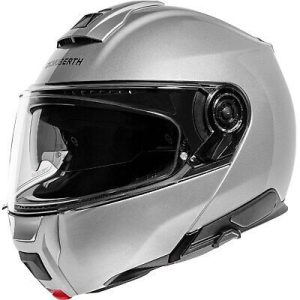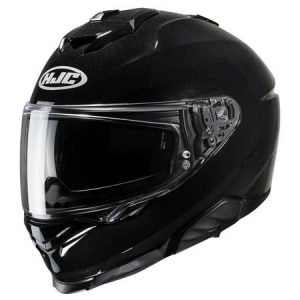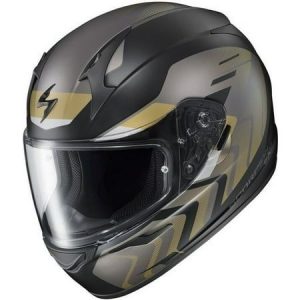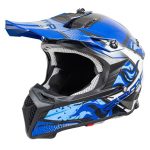A motorcycle helmet is your essential piece of safety gear. It’s the barrier between you and the pavement in a crash, and a properly fitted helmet can significantly increase your chances of walking away unscathed. But with various shapes, sizes, and features, achieving a perfect fit can feel overwhelming.
This comprehensive guide takes you through the steps of how to fit a motorcycle helmet, ensuring you find the one that offers optimal protection and comfort.

Knowing Your Head Size: The First Step
Before diving into helmet selection, it’s crucial to determine your head size. Grab a soft measuring tape and wrap it around your head, roughly one inch above your eyebrows. Ensure the tape maintains a level position throughout the measurement. Once you have the circumference in inches, consult the manufacturer’s size chart to find your corresponding helmet size. Remember, sizing can vary slightly between brands, so using a manufacturer’s specific chart is recommended.
Selecting the Right Helmet Style
Motorcycle helmets come in various styles, each offering different levels of protection and suitability for riding conditions. Here’s a quick breakdown of the most common types:
-
Full-Face Helmets: Offering the most comprehensive protection, full-face helmets enclose your entire head, including your chin and jaw. They’re ideal for high-speed riding and long distances.
-
Modular Helmets: Also known as flip-up helmets, modular helmets offer the functionality of a full-face helmet with the convenience of a flip-up visor for easier on and off.

-
Open-Face Helmets (3/4 Helmets): These helmets provide protection for your head but leave your face exposed. They’re popular for cruising and short trips in warmer climates but offer less overall protection compared to full-face helmets.
-
Half Helmets: Offering minimal protection, half helmets primarily cover the top of your head. While legal in some areas, they are not recommended due to the significant risk of facial injuries in a crash.
Putting the Helmet On: The Fitting Process
With your head size measured and helmet style chosen, it’s time for the crucial fitting process. Here’s what to do:
-
Open the Helmet Wide: Unfasten the chin strap and open the visor or face shield as wide as possible to create a large opening for your head.
-
Slide Your Head In: Hold the helmet by the chin bar and carefully slide your head in at an angle. The opening should be snug but not overly tight.
-
Check for Snugness: Once your head is inside, gently rock it from side to side. The helmet should feel snug and secure, with minimal movement. There shouldn’t be any pressure points or excessive gaps.
-
Chin Strap Test: Fasten the chin strap and ensure it’s comfortably snug. You should be able to fit no more than one or two fingers between the strap and your chin. A loose chin strap can allow the helmet to rotate in a crash, reducing its effectiveness.
-
Visor Check: Close the visor and ensure it seals properly against the eyeport. There shouldn’t be any gaps that allow wind or debris to enter.
-
Comfort Check: Keep the helmet on for a few minutes and assess the overall comfort. The padding should feel firm but not create pressure points.
Snug Doesn’t Mean Suffocating: Finding the Comfort Balance
While a snug fit is essential, your helmet shouldn’t feel uncomfortably tight or restrict your head movement. Here are some additional tips to ensure a comfortable fit:

-
Liner Break-In: New helmet liners can feel stiff initially. Wearing the helmet for short periods allows the liner to mold to your head shape, improving comfort over time.
-
Cheek Pad Adjustment: Some helmets offer replaceable cheek pads in different thicknesses. If your cheeks feel excessively compressed, consider trying a thinner size for a more comfortable fit.
-
Glasses Compatibility: If you wear glasses, ensure the helmet accommodates them comfortably. Try the helmet on with your glasses to check for any pressure points or restricted movement.
Taking it for a Ride: The Final Test
Once you’ve achieved a snug and comfortable fit, take the helmet for a short test ride. Pay attention to any wind noise, pressure points, or restricted movement that may arise during actual riding conditions. If you experience any discomfort, it’s crucial to adjust the fit or consider a different helmet model.
Don’t Settle for Anything Less Than Perfect: Invest in Your Safety
Finding the right motorcycle helmet is an investment in your safety. By following these steps and prioritizing a snug, comfortable fit, you can ensure your helmet provides optimal protection while maximizing comfort on every ride.

A properly fitted helmet should feel secure and snug without causing discomfort. If you’re uncertain about the fit or experience any pressure points, don’t hesitate to seek assistance from a qualified motorcycle gear salesperson. They can guide you through the selection process, ensure proper fitment, and answer any questions you may have.
Gearing Up for the Road Ahead: Essential Motorcycle Helmet Care Tips
Once you’ve found your perfectly fitting helmet, proper care is crucial to ensure its longevity and effectiveness. Here are some essential tips:
-
Cleaning: Regularly clean your helmet’s visor and outer shell using a mild soap solution and a microfiber cloth. Avoid harsh chemicals or abrasive cleaners that can damage the surface.
-
Liner Maintenance: Remove the helmet liner periodically and hand-wash it with lukewarm water and a gentle detergent. Allow it to air dry completely before reinstalling it.
-
Storage: When not in use, store your helmet in a cool, dry place away from direct sunlight. Excessive heat can degrade the helmet’s materials over time.

-
Inspection: Regularly inspect your helmet for any signs of damage, such as cracks, deep scratches, or loose components. If you find any damage, replace the helmet immediately for optimal safety.
Invest in Confidence: Ride with a Motorcycle Helmet You Trust
By prioritizing a proper fit and maintaining your helmet meticulously, you can ensure you’re equipped with the best possible protection on every ride. Remember, a motorcycle helmet is your essential piece of safety gear. Choose wisely, fit it correctly, and enjoy the freedom of the open road with confidence.
Ready to Find Your Perfect Motorcycle Helmet?
Now that you’re armed with the knowledge of how to fit a motorcycle helmet, it’s time to find the one that fits you perfectly. Visit your local motorcycle gear retailer or browse reputable online retailers to explore a wide selection of helmets. Don’t hesitate to try on different models and sizes to ensure you achieve that optimal balance of safety and comfort.


